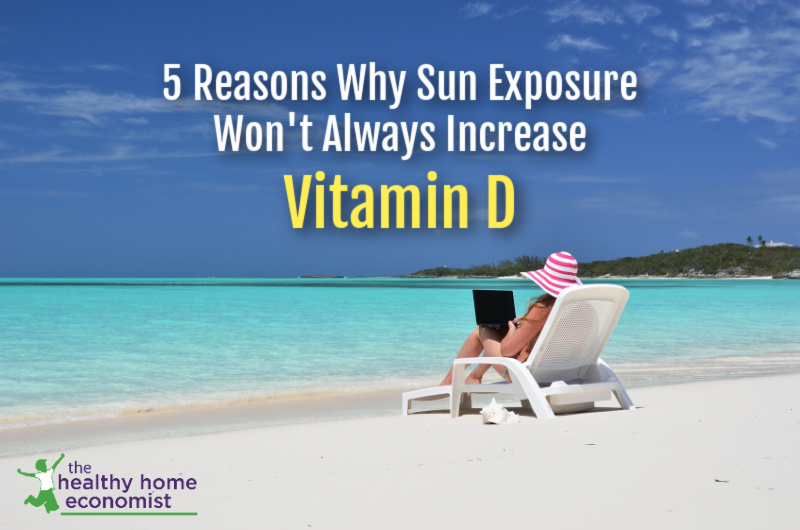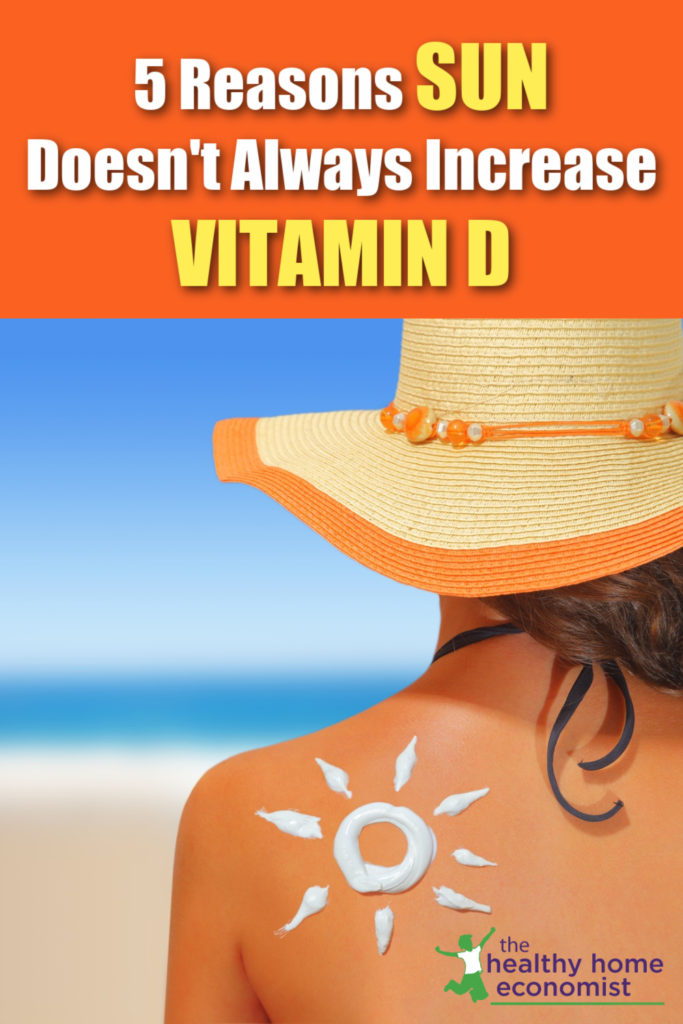Six reasons sun exposure won’t always increase blood levels of vitamin D and how to resolve the situation to get the most health benefits from sensible sunning.

Sun exposure is the cheapest and most effective way to quickly raise vitamin D into the optimum range.
And yet, some people are finding that adequate solar rays on a regular basis are failing to budge low levels of this critical nutrient discovered at the doctor’s office or via at-home vitamin D testing.
Low levels put a person at greater risk for viral infections of all kinds. Chronically low levels can result in degenerative conditions like osteoporosis, MS, depression, and cancer among many others.
Strange vitamin D deficiency symptoms such as a tendency toward a sweaty head can be an early warning sign to take action.
Frequently, however, there are no signs that your D is low until a serious health issue emerges seemingly out of nowhere.
Thus, it is important to ensure that every single time you get some sunlight, the experience positively affects your levels.
This is especially true since it is quite difficult to achieve excellent D status with diet alone.
How Much Vitamin D Do We Get from the Sun?
So, how much D do we actually get from the sun?
Massive amounts, as it turns out.
One study found that 30 minutes of midday summer sun exposure in Norway was equivalent to consuming 10,000–20,000 IU of vitamin D. (1)
Compare this to one of the best food sources, high vitamin cod liver oil, which contains about 300-400 IU per teaspoon.
In other words, you would need to take a daily dose for nearly a full month to get what the sun offers in as little as 30 minutes.
Exposure to the arms, legs, abdomen and back is recommended for maximum effectiveness. Yes, you can protect your face and neck and still get huge benefits! (2)
How quickly can sun exposure raise levels?
A study from the University of Pennsylvania found that participants experienced a 30-50-fold increase in the vitamin D in their blood within only 8-40 hours of exposure. That is very fast! (3)
Why Sunning Doesn’t Always Increase Vitamin D
So why doesn’t regular sun exposure always translate to rapidly improved vitamin D levels in the body for some people?
There are several reasons to consider if you are working toward 60 ng/ml, which is the level my doctor recommends as optimal especially for avoiding symptoms and complications from coronaviruses.
Deficiency levels of less than 20 ng/ml are common even in seemingly healthy adults with a significant number of people less than 10 ng/ml!
Eating Lowfat
Those who eat lowfat usually do not realize that they are putting themselves at risk for low vitamin D.
This type of modern diet typically contains little cholesterol, yet this nutrient is necessary to create the water-soluble form of vitamin D from sun exposure for transport throughout the body via the bloodstream.
Stephanie Seneff PhD explains the process:
Sunlight exposure stimulates cholesterol sulfate synthesis in the skin, and the sulfate moiety makes the [vitamin D] molecule water-soluble. This means that it can be transported in the blood without being packaged up inside an LDL particle. (4)
Cholesterol is only available via foods that contain animal fats such as butter, meat, eggs and full fat dairy.
Even high saturated fat coconut oil contains zero cholesterol.
The liver can theoretically make whatever cholesterol the body needs, but sufficient amounts are not always produced to sustain vitamin D levels from sun exposure.
Note that oxidized cholesterol in processed foods is not healthy and should be avoided. Only natural cholesterol from whole foods is the type that can be of benefit to raising vitamin D from the sun.
Getting Sun at the Wrong Time
Midday sun exposure during late spring, summer and early fall is the optimal time for making vitamin D. This is when the UVB rays are at their peak.
UVA rays which predominate before 10am and after 4pm do not have any effect on vitamin D production via the skin.
Strange that it is the midday rays that authorities typically warn people away from, yet this is the most beneficial sun of all!
Note that UVB rays are not available at any time of day during the winter months for more northern climes.
Hence, dietary sources like a daily dose of unprocessed high vitamin cod liver oil (this is the best brand according to my research) become extremely important at this time.
Using Sunscreen
While there is nothing wrong with using a safe, non-chemical based sunscreen (I use this brand) to prevent burning, it is important to know that while it is on your skin, your body won’t be making any vitamin D.
The UVB rays are most effectively blocked by sunscreen. SPF 15 blocks approximately 95% of UVB rays and SPF 30 blocks about 97%. (5)
To make the maximum amount of vitamin D, try this trick that I use.
- Spend the first 10-30 minutes in the midday sun without any sunscreen (go shorter based on the sensitivity of your skin…no burning or pinkness is the goal!).
- Get into the shade for a bit to allow the vitamin D to absorb into the body. Another 30 minutes is my rule of thumb.
- Slather on some nontoxic sunscreen and enjoy the rest of your time outside!
Another good practice is to not shower immediately after you’ve experienced a short, nonburning jaunt in the midday rays. This is to allow time for the vitamin D to absorb into the blood. Showering using no soap on the exposed areas helps too if you must clean up more quickly.
Spray Tan
Spray tans have really gone mainstream over the past few years. It seems that literally anyone who appears on TV has one.
Many regular folks are opting for spray tans too…perhaps because they believe it safer than tanning beds?
It’s hard to know what the reasoning for this trend might be, but the bottom line is that you should avoid this cosmetic procedure.
Most people have no idea that spray tans block your skin’s ability to make Vitamin D from sun exposure.
Not to mention the toxicity of all those microparticles that have access to getting into the bloodstream. Who knows what the long term effects might be?
If you are trying to improve Vitamin D levels using sun as a key natural tool, avoid getting spray tanned!
Statin Drugs & Some Herbs
Statin drugs artificially lower cholesterol levels in the body.
Some herbs such as sea moss will do this as well if you take them in therapeutic doses for more than a short period of time…so beware!
Hence, it should come as no surprise that those taking these types of substances can experience a sub-optimal vitamin D response to midday sun.
While avoidance of these drugs with the help of a knowledgeable functional physician is the best policy, if you must take them for whatever reason, dietary vitamin D becomes more important than ever.
Wild fish eggs are the best source as is pastured lard and high vitamin cod liver oil.
When higher doses are needed, natural vitamin D drops are a good idea to consider. I take these myself in the winter when sun exposure is limited. This ensures maintenance of my summer vitamin D levels all year long.
Sulfur Deficiency
Adequate sulfur status is crucial for making the water-soluble form of vitamin D that can traverse freely through the body.
Eggs are the number one source especially from chickens free ranging outdoors. Unfortunately, some people still avoid nature’s perfect food due to a misguided (and long debunked) fear of cholesterol and saturated fat.
Conventional nutrition seems to have all but forgotten about sulfur too, with a minimum daily requirement (MDR) not even established! This despite the fact that sulfur deficiency is widespread, it is the eighth most common element by mass in the human body, and countries with the highest consumption are some of the least obese with low rates of cardiovascular disease.
Eating more eggs is the best way to get more in the diet with onions and garlic also excellent sources if they are grown in nutrient-dense soil.
Since sulfur absorbs readily through the skin, regular bathing in Epsom salts (magnesium sulfate) is another great practice for ensuring you have sufficient levels in the body for making vitamin D from sun exposure.

References
(1) The Sun is Your Best Source of Vitamin D
(2) How Much Time in the Sun Do You Need for Vitamin D?
(3) Link between Skin Pigmentation and Vitamin D Absorption
(4) Sunlight and Vitamin D are Not the Same Thing
(5) What Does the Number on the Sunscreen Mean?








I’m pretty deficient in Vitamin D. Would it be wise to take the Perfect Supplements drops along with my daily dose of Dropi Cod Liver Oil for a short time?
If you have personal questions, please use the purple chatbox. Thanks, Jenn (comment moderator)
I would imagine that stress depletes vitamin D levels as it has a huge effect on most or all things in the body. Stress especially from early childhood/intergenerational trauma and adversity is the massive and massively neglected subject in health, the primary causer of poor health that most people are just not aware of and don’t talk about. Everyone is full of nutritional and other advice, but they are missing the elephant in the room. Gabor Maté MD illuminates the incredible and incredibly underrecognized relationship between stress/emotions/relationships/trauma and all the systems of the body.